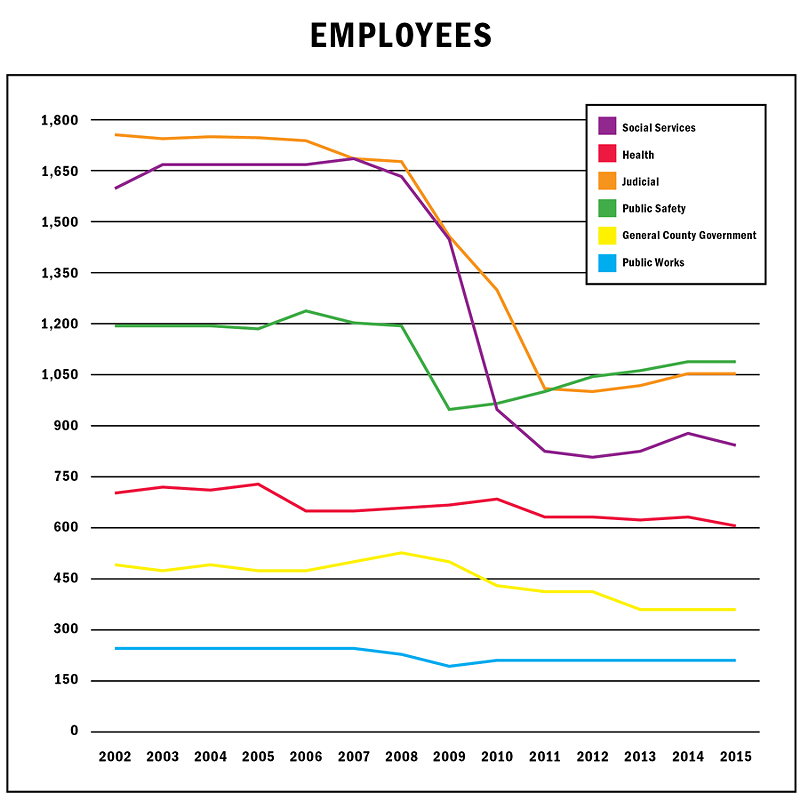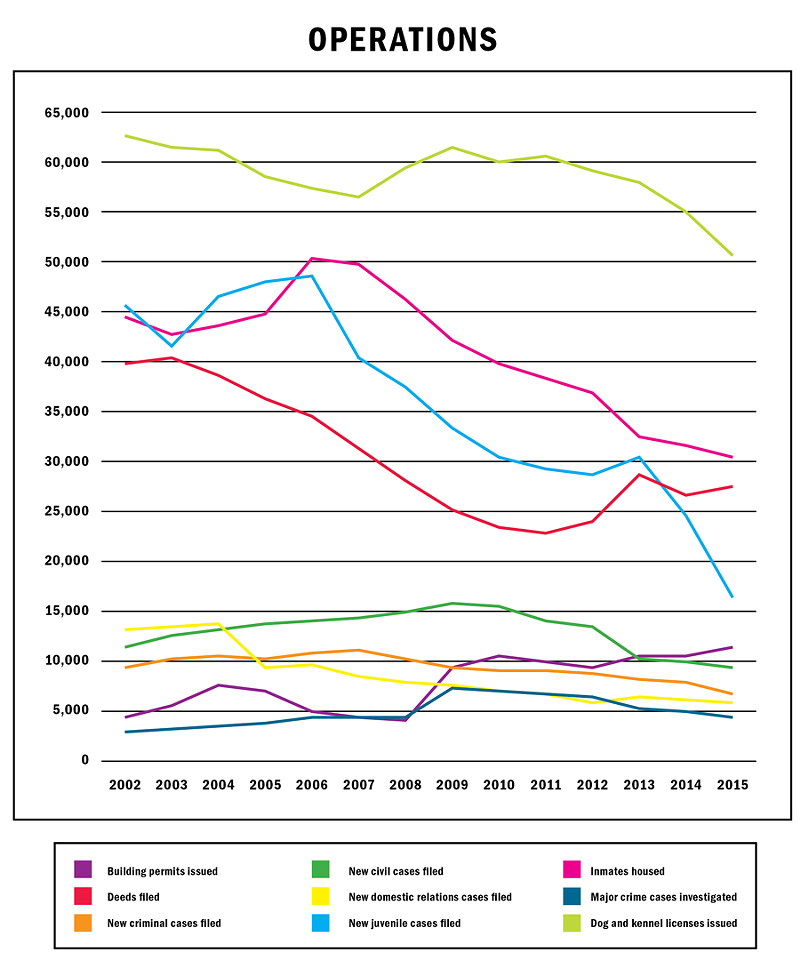
Hamilton County’s population and economy are climbing back to where they were a decade ago. But the county’s government has shriveled into a husk of its pre-recession self.
The portrait of a government that people use less, need less and encounter less often comes from Hamilton County’s financial report for calendar 2015, released by the Ohio State Auditor’s office in October. It reveals steep drops in county spending, county government employees and “operating activity” over the past decade. In many instances, the numbers are the lowest since the 1990s.
Among the most significant drops from 2006 through 2015:
• Total spending on the county’s basic governmental functions, not counting stadiums and the sewer district, fell 33 percent, from $974.4 million to $656.8 million, unadjusted for inflation.
• Spending on public safety and public works both fell substantially, reaching levels not seen since 2002.
• The county’s full-time employee headcount dropped to a decade-low of 4,289, down from 6,272, or 32 percent.
• Property tax revenue fell 12 percent, from the record $263.6 million raised in 2006.
• New civil lawsuits in Common Pleas Court fell 35 percent, while new criminal cases fell 38 percent.
• New juvenile cases plunged 66 percent, from an all-time high of 48,647 in 2006 to 16,468 in 2015.
• The number of county jail inmates fell by almost 40 percent.
• Calls to 911 fell 39 percent.
Michael Jones, an assistant professor of economics at the University of Cincinnati, notes that most of the decline in spending coincided with sharp revenue drops. Outside grants and contributions were heaviest prior to and during the Great Recession of 2008-09.
“You’ve got a decline of about $200 million in operating grants,” Jones says. “I suspect that some of that has to do with state and federal subsidies declining since 2009 that provided economic assistance during the recessionary period.”
As the county’s budget shrank, so did its payroll. The Department of Job and Family Services saw its headcount cut in half from 2008 to 2011. Amazingly, the agency is serving more Medicaid and food stamp recipients than ever before.
“We’re almost all funded by the state and feds and when we went through the recession, we had our allocations cut severely and had to respond in kind,” says department spokesman Brian Gregg. “We became a more efficient organization. We got creative and innovative. … We now do re-certifications over the phone instead of in person. We have a robust document-imaging system to help with document management and we have kiosks where people can input necessary paperwork right from our lobby.”
Some of the county’s revenue decline stems from a drop in the value of property for tax purposes and the corresponding 12 percent drop in property tax collections. Total residential assessments hovered at about $14 billion from 2005-2010, but slumped and leveled off at the $12.7 billion mark. Commercial property assessments for 2014 and 2015 were the lowest since 2002.
County Auditor Dusty Rhodes says the revenue drops have taken a big bite out of county payrolls. His office, for instance, had a staff of 174 when he became auditor in 1991. It has 85 today. He said the recorder’s office is half its size of a decade ago.
Perhaps surprising, the downsizing has impacted law enforcement, too. In 2006, the county had 1,231 people working in public safety. By 2015, it was down to 1,089. The number of major crime investigations fell in tandem, down 39 percent since 2009.
“When people discuss government spending and resources, they talk about fat, then muscle and, finally, bone,” says Hamilton County Sheriff Jim Neil. “I can tell you our office has been cut to the bone at the same time more is being asked of us every day.
“Ten years ago we weren’t facing a heroin epidemic like we’ve never seen before, or the gun violence and animosity toward law enforcement across the country,” Neil says. “Everyone wants the services, but when the bill comes, no one reaches for their wallets. We’re working with (county) commissioners to make the safety of the public and the safety of my deputies serving our communities more of a priority.”
The decline in major crime investigations contributed to a downturn in another branch of government. In 2015, the number of new criminal cases filed in Hamilton County Common Pleas Court fell to its lowest level since 1998. Most cases come from the Cincinnati Police Department, whose felony case count fell 36 percent from 2007 to 2015, says CPD spokeswoman Tiffaney Hardy.
The downsized Sheriff’s Department did lead to a massive dropoff in county jail lockups, from 50,727 in 2006 to a historic low of 30,985 in 2015. The county closed its 822-bed jail in Queensgate in 2008, and taxpayers have rejected sales tax hikes for a new one. Consequently, Sheriff’s Department spokesman Mike Robison says, the department places fewer non-violent offenders in jail when it has the discretion.
Things are also quieter in the county’s civil courtrooms. In 2009, 15,621 new lawsuits were filed with the court. Six years later, the number was down to 9,182.
Catherine Glover, executive director of the Cincinnati Bar Association, chalks it up to the steady drop in home foreclosures, tort reform and the settlement of disputes before they reach the courthouse. Many of those settlements are achieved through so-called “alternative dispute resolution (ADR),” including, like it or not, arbitration.
Ryan McLane, a lawyer at Dressman Benzinger LaVelle and chairman of the bar association’s ADR practice group, says its use has grown in Greater Cincinnati in the past decade.
“People have the tools and the incentive to settle their cases earlier without the expense and risk of trial,” McLane says.
Business is down almost across the board in the county courthouse. New Juvenile Court filings dropped 66 percent over 10 years, perhaps suggesting a generation of better-behaved kids. And the number of Domestic Relations Court filings is less than half the intake of the early 2000s. Court Administrator Lisa Gorrasi says it reflects population decline, fewer domestic violence petitions and fewer divorces.
Fewer divorces occur in part because there are fewer marriages, which means less clerical work in another arm of the county’s judiciary, Probate Court. Court Administrator Vince Wallace says 5,302 couples married in 2003, while 4,936 did so in 2016.
Not only did fewer Hamilton Countians marry, they registered fewer dogs with the auditor’s office. In 2015, 50,638 dog and kennel licenses were issued. In previous years, most recently 2011, the number topped 60,000.
What went up in the past decade? Sales tax receipts hit a record $114.9 million in 2015, up 78 percent since 2006. And the county issued 11,125 building permits in 2015, a new record, more than double the 4,847 in 2006.
Two more indicators at lofty levels point to disparities in the economic recovery. The county reported a monthly average of 225,000 Medicaid recipients in 2015, a record number that has grown yearly since the federal-state expansion of that program. Meanwhile, the monthly average number of food stamp recipients in 2015 remained high at 125,808.
“The reason why we have so many food stamp recipients,” Gregg says, “is because people are either out of work or they lost a job and took one that paid less than they were making and became eligible because their income was lower.”




